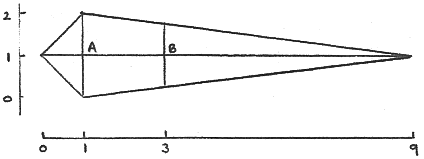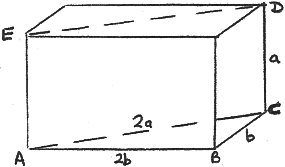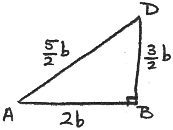Figure 1: to scale

We must be very careful here. How are we to decide upon whether or not a coincidence is ‘meaningless’ or ‘not significant’?
The traditional archaeologist (e.g. Gillings) would take Mr Ivimy’s point (7) and point out that as there is no evidence for the Egyptian use of φ (in spite of Kielland et al.), and as there is no evidence for the Egyptian use of Pythagorean Triangles (in spite of Plutarch, see later), then Mr Ivimy’s point (7) must be considered a meaningless coincidence. Like the latitude of Budge-Budge, it is a product of a modern numerical imagination, with its love of number patterns, not of Ancient Egyptian Mathematics.
As to Mr Ivimy’s statement in his opening paragraph that the coincidence theory “asks us to believe that obviously rational men abandonned reason” – far from it. That the G.P. was very carefully designed before being built, no-one can have any doubt. But that it was deliberately built, according to some of the plans postulated by later pyramid speculators – of which Mr Ivimy is one in a long chain – is open to doubt.
Mr Ivimy’s appeal to plausibility is also a tricky point. Plausibility is an essentially subjective experience which, especially in the context of our folio, is virtually valueless. That Mr Ivimy’s judgement of plausibility is worth either more or less than any other contributor’s judgement of plausibility, is highly debateable.
I have no doubt that Conar MacDari considered his theory of the Irish Origin of the G.P. (a sort of inverse theory to Mr Ivimy’s) to be plausible; and that those archaeologists who consider the G.P. to be “a tomb, and nothing but a tomb”, also consider Mr Ivimy’s theory “implausible”.
R. A. Proctor, in the old journal Knowledge, raised a very interesting point which is connected with Mr Ivimy’s statement that “Most extraneous coincidences … are obviously meaningless in that they could not possibly have been produced by a human decision etc…”
Proctor took three coincidences related to the siting of the G.P. (each of which is only approximately true, and the second of which has been claimed as false):
1. It is at the centre, area-wise, of the world’s habitable land surface.
2. It lies on the meridian of maximum land, and the latitude parallel of maximum land.
3. It lies at the centre of the Nile Delta Quadrant (see Mr Rutherford’s first contribution; also my reply to it.)
As Proctor pointed out, it is not just remarkable, (if true), that the Egyptians located such a spot and built the G.P. there; it is a remarkable coincidence on the part of the Earth’s land surface and its configuration that all the points (1) to (3) actually do coincide. That the centre of the Nile Delta Quadrant should happen to fall upon the same spot as the centre of the habitable land surface is remarkable in itself; and points (1) and (2), in spite of their similar sounding nature, are not necessarily coincident at all (see fig. 1. at end).
So then, before any pyramidologist begins to capitalise upon points (1) to (3), and to tell us that such remarkable things do not happen by simple coincidence, he had better reflect upon the fact that such a remarkable coincidence already has happened, in the configuration of the earth’s surface, an unplanned ‘freak’ of Nature. (I suppose it could be claimed, if the Biblical Theory is accepted, that God planned it this way; otherwise the coincidence must be considered, in Mr Ivimy’s sense,‘meaningless’.)
Of course, “the fact that Budge-Budge lies on a latitude which has peculiar mathematical properties makes it neither more nor less likely that Stonehenge or the G.P. were sited where they were because of the mathematical properties of their latitudes”, but Budge-Budge does constitute a neatly encapsulated ‘model’ of what might be going on as regards the G.P.
Suppose for the sake of argument that you met someone who proclaimed that Budge-Budge was a sacred city (this might even be true, I don’t know); that the city was laid out according to religous symbolism (this also might be true, I suppose); and that its site was chosen because this particular latitude has interesting mathematical properties connected with that religous symbolism.
How much of this story would you believe ?
Perhaps you would say, “Ah, grant you that the place may be sacred, and that certainly the city wasn’t slung together any-old-how, but this business about its latitude – I mean surely they built it there because that’s where the river happened to enter the sea, or something such. All this ‘sacred mathematics’ is incidental stuff supplied by your over-active imagination. Budge-Budge had to be built on some latitude, and it just happens that this latitude has these mathematical properties you mention.”
“But,” replies your opponent, “surely that is stretching coincidence too far. Budge-Budge, a carefully planned city, just happens to have a latitude with these extraordinary properties? You ask me to believe that this is a simple coincidence of numbers and an over-active imagination on my part?”
“Look at it this way,” you might reply, “There is a village in Mexico with exactly the same latitude as Budge-Budge. Yet surely you wouldn’t claim that this village too had its site chosen because of its latitude’s mathematical properties? Or that every tine a ship or an aeroplane crosses over this particular latitude parallel, it does so for mathematical reasons?”
Your opponent replies: “Of course anything on the same latitude parallel has the same properties, but that doesn’t make it any the more or less likely that Budge-Budge was built where it was for these reasons.”
(End of conversation: numerous murmurs of content/discontent. Exeunt. Enter now two persons discussing the reasons for the choice of Great Pyramid slope etc.)
Point (2). It is possible that Mr Ivimy’s 3:4:5 hypothesis for the King’s Chamber construction is an unintended by-product of a simpler design involving nothing more sophisticated than the double square. (See fig. 2 and note at end.)
If this is so, then this throws doubt on the bulk conclusion he derived in points (1) to (5).
Point (1). I think that here Mr Ivimy refers to Chapter 56 of De Iside et Osiride, the relevant section reading as follows: “One might suppose that the Egyptians liken the nature of the universe especially to this supremely beautiful of the triangles which Plato also in the Republic seems to have used in devising his wedding figure. That triangle has a vertical of three units of length, a base of four, and a hypotenuse of five, which is equal, when squared, to the squares of the other two sides. The vertical should thus be likened to the male, the base to the female, and the hypotenuse to their offspring; and one should similarly view Osiris as the origin, Isis as the receptive element, and Horus as the perfected achievement etc.” (J. Gwyn Griffiiths translation, Univ. of Wales Press, 1970)
But there remains the question: what was Plutarch’s source here? Plutarch is believed to have visited Egypt, so he could have got it direct from Egyptian priests. On the other hand, it is known that Plutarch quoted other Greek authors, so this reference to the 3:4:5 could be a quotation from another Greek author who had intruded Greek ideas into Egyptian Mythology. Certainly Plutarch’s statement lacks directness: “one might suppose that …”.
R. J. Gillings, in his Mathematics in the Time of the Pharaohs (1972), states, in his appendix 5, that there is no evidence that the Egyptians were even acquainted with Pythagorean Triangles, including the simplest 3:4:5 case.
Points (7) and (9). Schwaller de Lubicz I am not familiar with. But another of Mr Ivimy’s sources, Else Christie Kielland’s Geometry in Egyptian Art (1955), I am familiar with. It is my opinion that Kielland’s ‘discovery’ of φ in Egyptian art is a tortuously complex mare’s nest. I find it disturbingly unconvincing, and rather ‘far fetched’. I suspect that φ analysis could all too easily be applied to the centre spread of Playboy. I stress that the above is simply an opinion.
As I have said for the use of the 3:4:5 triangle in the King’s Chamber, I feel that the apparent associations of φ and π with the G.P. are accidental by-products of simpler designs.
There is no evidence that the Egyptians knew anything of φ, as Kielland admits: “But no Egyptologist has ever found it mentioned in any hieroglyphic text. Which does not exclude the possibility of its being found in the future.” (p. 12)
Point (8). It depends what you mean by a “reason for this preference”. See D’Arcy Thompson, On Growth and Form, Vol. II. Ch. xiv.
Point (10). A reference for this Egyptian π = 22/7, please. As I have cited elsewhere in this folio, Gillings (p. 197), from an Egyptian Problem Study, shows quite conclusively that the Egyptian equivalent of our π, in the sense of circumference/diameter, was 256/81 which equals 3.1605.
Point (12). Mr Ivimy rightly points out that the π/φ Pyramid Theory could be accident yet claims first, that his chapter 12, and second, that the 5π/6 term in two types of stone circle perimeters, give the coincidence theory its marching orders.
I do not find any significance in the repetition of the 5π/6 term. To me it is simply a case of the same fraction of π, arising from a modern consideration of the radian measure of circular arcs, in two different ways. In the type A ring it arises from 2π/3 + π/6, and in the type B from π/2 + π/3.
As to Mr Ivimy’s chapter 12, its significance would seem to rest on subjective and highly speculative foundations.
For example, I find Mr Ivimy’s interpretation of the meaning of the expression “Ra of the Two Horizons” a little strained. To me the two horizons were simply the East (rising; birth) and the West (setting; death). The two lions face in those two opposite directions, one to the East and one to the West. The disc is flattened because at the rising and setting of the Sun, its disc is apparently flattened by atmospheric refraction. Mr Ivimy’s introduction of ‘frames of reference’ for the two horizons, and avoidance of π to explain the flattening of the disc, would seem to me to be unwarranted.
Again the reincarnation–moon’s phases allegory is interesting, but it is hardly concrete; and I feel that Mr Ivimy has let his allegory overstep its bounds, and allowed his theory to enter the realms usually occupied by the more woolly minded theosophists, when he writes, on p. 153, “the astronomers calculated that the nodal points of birth and death where the infinitely small particles of the soul’s ‘body’ make their first and last contacts with earthly matter would be the two points where powers of φ coincide most nearly with fractions of π & etc.”
This section of Mr Ivimy’s book is poetic, certainly. But how much weight does it really carry ? Each of Mr Ivimy’s readers must answer that for themselves. For myself, the answer is ‘not much’.

The diagram shows a kite-shaped piece of land. A is the point on both the meridian of maximum land and the latitude parallel of maximum land. B is at the centre of the piece of land, area-wise, as a simple calculation shows.

First, lay out the floor, a double square b units by 2b units. Measure the diagonal of the floor (2a), half it, (a), and build the walls up to this height. (The diagonal cross-section ACDE is thus itself a double square a units by 2a units.)
Notice that this construction involves no knowledge of the Pythagoras Theorem, and, in particular, does not involve the deliberate use of the 3:4:5 triangle.
Yet modern analysis shows that in following the above scheme, the triangle ADB inadvertently takes on the proportion 3:4:5.

Proof. Apply Pythagoras to triangle ABC: (2a)2 = (2b)2 + b2
a = b√5/2
BD = √(a2 + b2) = 3b/2 and AD = √(AB2 + BD2) = 5b/2
Thus DB:BA:AD = 3:4:5 (cf. Mr Ivimy’s comment (2))